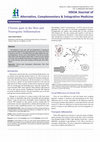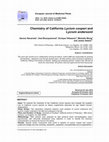medicine by James D Adams

James D. Adams, PhD has published extensively in the field of Pharmacology. The subject of his di... more James D. Adams, PhD has published extensively in the field of Pharmacology. The subject of his dissertation at UC San Francisco was ketamine metabolism. He has published on oxidative stress and developed assays for GSH, GSSG as well as the pyridine nucleotides NADPH, NADP, NADH and NAD. In several publications, he elucidated the primary targets of oxygen radicals and showed that DNA is an early and very sensitive target of oxidative stress. DNA fragmentation initiates pathways of apoptosis or necrosis. Parkinson's disease, stroke and other brain conditions caused by oxidative stress are another area of his expertise. He holds a patent for the use of nicotinamide, vitamin B3, in stroke and other neurodegenerative conditions. He described the oxidative stress mechanism of MPTP, the toxin that can cause a parkinsonian syndrome. He also discovered how tyrosine hydroxylase, monoamine oxidase and aldehyde dehydrogenase produce oxygen radicals in the brain. Dr. Adams has worked on California traditional healing and plant medicines for many years. He has described the phytochemistry of several California plants including chia Salvia columbariae, fire poppies Papaver californicum, California sagebrush Artemisia californica, toyon Heteromeles arbutifolia and chamise Adenostoma fasciculatum. S. columbariae was found to contain tanshinones and beta-sitosterol lithospermate. Chia is useful in the treatment of stroke and is similar to the Chinese plant Salvia miltiorrhiza. P. californicum provided challenging chemistry in the discovery of papaverine and 14-methylnormophine sterol glycosides. A. californica was shown to contain 15 monoterpenoid pain relievers and 5 sesquiterpenoid analgesic agents. A. fasciculatum demonstrated glutinol, phytosterols and other topical anti-inflammatory agents useful in Adams disease and eczema. The results from Dr. Adams work on H. arbutifolia are submitted. H. arbutifolia is a traditional treatment for Alzheimer's disease. Dr. Adams also discovered, named and described a new disease, Adams disease, which is caused by overly active transient receptor potential cation channels in the skin and other organs. Adams disease is providing new insights into the causes of retinal tears, varicose veins, deep vein thromboses and other conditions.
This review discusses new mechanisms for the induction of Alzheimer's disease, involving lipid to... more This review discusses new mechanisms for the induction of Alzheimer's disease, involving lipid toxicity and adipokines. Ceramide induces oxidative stress and the formation of amyloid . Visfatin induces oxidative stress, damages the blood brain barrier and increases the attraction of monocytes, neutrophils and other white blood cells. A new mechanism for visfatin/NAD (nicotinamide adenine dinucleotide)-induced oxidative stress is presented involving redox cycling catalyzed by xanthine dehydrogenase and NADH oxidase. These mechanisms are discussed in terms of the treatment of Alzheimer's disease.
Adenostoma fasciculatum is used traditionally to treat skin conditions such as eczema. The plant ... more Adenostoma fasciculatum is used traditionally to treat skin conditions such as eczema. The plant was found to contain monoterpenoids, including hydroquinone and geranial. Other terpenoids were found, including the triterpenoids 7α-hydroxybaruol and glutinol, the diterpenoids thalianol and thaliandiol as well as the steroids suberosol and campesterol. The new compound, 7α-hydroxybaruol, was further analyzed by two-dimensional nuclear magnetic resonance (NMR) imaging, 13 C NMR and high-resolution high-performance liquid chromatography combined with mass spectrometry. A balm was made from the plant with olive oil and bees wax. Several patients tried the balm and reported improvements in Adams disease, eczema symptoms and seborrhea within 1 week.
Adams disease is the consequence of overly active transient receptor potential cation channels (T... more Adams disease is the consequence of overly active transient receptor potential cation channels (TRP). This case report presents a patient suffering from multiple vascular problems and may provide new insights into the causes of venous problems. Endothelial and smooth muscle cells in veins contain TRP. These channels when activated excessively result in calcium accumulation, oxygen radical formation and apoptosis of endothelial and smooth muscle cells. The death of critical cells in vein valves, may lead to varicose veins. The loss of endothelial cells in venules may lead to retinal tears. Damage to vein walls may lead to a deep vein thrombosis. Transient receptor potential cation channels may be new drug targets of interest in the treatment or prevention of these conditions.
Papers by James D Adams
Many websites are dedicated to educating the public about chronic pain and its management. The ma... more Many websites are dedicated to educating the public about chronic pain and its management. The majority of these websites say there is no cure for chronic pain, but encourage patients to try exercise, diet, stress reduction and other techniques to decrease the severity of chronic pain. Patients are also taught to use oral or injected drugs to treat their chronic pain. This can be dangerous and leads to adverse events and death in some patients. The majority of these websites teach patients that chronic pain comes from the brain and brain stem. This teaching is incorrect, since chronic pain is generated in the skin and can best be treated and cured with topical medicines.

Journal of Pain and Relief, Jun 23, 2015
A pain cycle exists in the body that can begin in skin sensory neurons, continues to the spinal c... more A pain cycle exists in the body that can begin in skin sensory neurons, continues to the spinal cord and the brain, and then returns to the spinal cord and the skin. Analgesia can occur at any of these neurons to break the pain cycle. Upon initiation of the pain cycle in chronic pain, several changes occur including cyclooxygenase 2 induction in the skin. Cyclooxygenase 2 is the major source of PGE2 that enhances pain at transient receptor potential cation channels in the skin. A traditional California plant medicine, made from Artemisia Californica, was found to be an effective treatment of severe and chronic pain including broken bones, cancer pain, back pain, fibromyalgia, diabetic neuropathy and more. The liniment contains mono terpenoids and sesquiterpenes. Transient receptor potential cation channels are the major pain receptors in the skin and can be inhibited by mono terpenes such as camphor, menthol and eucalyptol. These mono terpenes cross the skin and provide pain relief for several hours. Sesquiterpenes can cross the skin and inhibit cyclooxygenase 2. The combination of mono terpenes and sesquiterpenes in the liniment provides several hours of pain relief. Biography James D Adams received a PhD degree in Pharmacology from the University of California San Francisco in 1981. He has been a faculty member at the University of Southern California, School of Pharmacy since 1987. He has over 230 publications and has done research on several pain medications. He received training from a California Indian Healer and is an expert on plant medicines. He will discuss his work on a pain liniment made from California sagebrush that is effective even in severe pain such as broken bones. Several hundred patients have used the liniment. He will discuss the chemistry and pharmacology of the liniment and will discuss safety issues of the liniment in comparison to opioids and NSAIDs.
OBM Integrative and Complementary Medicine
Oral pain medicines are routinely used to treat pain and chronic pain. Recent evidence shows that... more Oral pain medicines are routinely used to treat pain and chronic pain. Recent evidence shows that many of these medicines actually increase chronic pain when used over several weeks. Patients should be encouraged to find alternative pain treatments and avoid oral medicines for pain.
Journal of Pharmaceutics and Drug Development, 2017
Current Medicinal Chemistry, 2020
Medicinal plants of the west – cultural and scientific basis for their use third edition revised ... more Medicinal plants of the west – cultural and scientific basis for their use third edition revised was released in 2016 by Abedus Press [1]. It is a self-published book that has been very successful. The book has 271 pages with 116 color photographs, 309 references and an index. The book has been used as a text book for the past 10 years by the Pharmacy Students at USC who have the option of taking a class in Chumash Healing. It is also a reference for the Medical Students at USC who have the option to study complementary and alternative therapies.

Journal of Alternative, Complementary & Integrative Medicine, 2019
Most pain is sensed in the skin, even pain from broken bones, cancer, kidney stones and other int... more Most pain is sensed in the skin, even pain from broken bones, cancer, kidney stones and other internal causes [1,2]. This is because internal pain transmitting neurons communicate with pain sensing neurons in the skin that communicate with the brainstem [1,2]. Chronic pain involves a number of interrelated mechanisms in the skin and other areas [3,4]. Many receptors on skin sensory neurons are responsible for sensing pain and prolonging pain, especially Transient Receptor Potential (TRP) cation channels. Many different TRP channels exist on skin sensory neurons. Populations of specific TRP channels are found on different neurons. The pain chemokine cycle in the skin prolongs and worsens chronic pain [5,6]. Damage to or activation of a sensory neuron in the skin causes the release of chemokines that attract neutrophils and macrophages (Figure 1) into the skin [5,6]. Neutrophils secrete leukotrienes that activate TRP channels on skin sensory neurons causing pain [7]. Leukotrienes can have long half-lives, perhaps allowing them to induce pain in many neighboring neurons over a long period of time.

European Journal of Medicinal Plants, 2019
Aims: To examine the chemistry of two California Lycium species and evaluate the possible use of ... more Aims: To examine the chemistry of two California Lycium species and evaluate the possible use of California Lycium species as dietary supplements especially for age related macular degeneration. Study Design: This exploratory analytical research used samples of Lycium andersonii and Lycium cooperi collected in the field and analyzed in the lab. Place and Duration of Study: University of Southern California School of Pharmacy, 1985 Zonal Avenue, Los Angeles, CA USA 90089. Methodology: Plant extracts were analyzed by high pressure liquid chromatography mass spectrometry with ultraviolet photodiode array detection in order to identify the chemical characteristics of compounds found in the plants. Results: Several known compounds were found in extracts of Lycium cooperi and Lycium andersonii foliage and fruit including: zeaxanthin, zeaxanthin monopalmitate and β-cryptoxanthin. The various California species of Lycium are discussed as possible alternatives to Chinese Lycium barbarum. Co...
OBM Integrative and Complementary Medicine, 2019
OBM Integrative and Complementary Medicine, 2018











Uploads
medicine by James D Adams
Papers by James D Adams